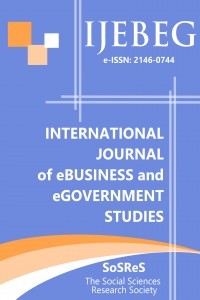INTEGRATION AND SYSTEM FAILURES OF ELECTRONIC GOVERNMENTAL PROCUREMENT SYSTEMS IN TURKEY AND PROPOSALS FOR MORE EFFICIENT SYSTEMS IN THE LIGHT OF B2B PORTAL MOVEMENTS
INTEGRATION AND SYSTEM FAILURES OF ELECTRONIC GOVERNMENTAL PROCUREMENT SYSTEMS IN TURKEY AND PROPOSALS FOR MORE EFFICIENT SYSTEMS IN THE LIGHT OF B2B PORTAL MOVEMENTS
e-government, e-procurement B2B portal, web based procurement.,
___
- Meeker, C.P., (2000, April). “The B2B Internet Report, Collaborative Commerce”. Internet
- Publication of Morgan Stanley Dean Witter, Equity Research North America, p. 25. DMO, 2011 Access Date. http://www.dmo.gov.tr/duyurular/DMO_Bilancolari/2008_Ayrintili_Tesekkul_Bilancosu.pdf
- Drucker, V., (2000). B2B Boom. Global Finance; http://www.findarticles.com/p/articles/mi_qa3715/is_200004/ai_n8893387. http://www.alibaba.com/about/en/AboutOurCompany/history_milestone.html retrieved 3/27/2011. http://www.ihale.gov.tr/Istatistikler_Raporlar/faaliyet_raporlari.htm http://www.ihale.gov.tr/kurum_hakkinda/faaliyet_raporlari.htm
- Kartalci K. 2010, “Directorate General of State Supply office, and the Public Procurement System in Turkey”, Electronic Journal of Social Sciences, ISSN;1304-0278, (Spring-2010), 9, 32.
- KIK, (2011) KAMU ALIMLARI İZLEME RAPORU 2010, March 2011 Ankara.
- Lee, H.L., Padmanabhan, P., Whang, S., 1997a. “Information distortion in a supply chain: The Bullwhip Effect”. Management Science 43, 543–558.
- Yamamoto, GT., Karaman, F 2007, “Barriers to E- Procurement Adoption: The Turkish Case”. In
- E-Procurement in Emerging Economies (Pani & Agrahari Eds), Hershey: Idea Group Publishing, 126. Yildirim F., (2010), “The Factors That Affect the Company’s B2b Overall Use Throughout the B2b Portal Transactions and a Survey in Turkey”. The International Academy Of E-Business
- Tenth (10th) Annualconference, San Francisco, California, April 1 to 4, 2010, page 143-148.
- Başlangıç: 2009
- Yayıncı: Sosyal Bilimler Araştırmaları Derneği
THE EFFECTS OF E-COMMERCE ON SUPPLY CHAIN IN TURKEY
Gülsüm AYDIN, Sibel BAYAR ÇAĞLAK, Güler ALKAN
İhsan Tolga MEDENİ, Tunc MEDENİ, Mehmet TOLUN
INTERNET MARKETING IN THE PUBLIC SECTOR: THE CASE OF INVESTMENT PROMOTION AGENCIES
İddi MAKOMBE, Muhajir KACHWAMBA
DOES INFORMATION TECHNOLOGY CAPABILITY IMPROVE BANK PERFORMANCE? EVIDENCE FROM TURKEY
SOPHISTICATION OF E-SERVICES IN TURKISH PROVINCIAL MUNICIPALITIES: RECENT STATUS
Fazli YİLDİRİM, Gonca TELLİ YAMAMOTO
INTEGRATION OF TURKISH EID WITH E-GOVERNMENT & E-BUSINESS SERVICES
Oktay ADALİER, Mucahit MUTLUGUN, Ahmet Fatih MUSTACOGLU
WOMEN EXCLUDED OR EMPOWERED? A CASE FOR DIGITAL LOCAL AGENDA IN EUROPE
